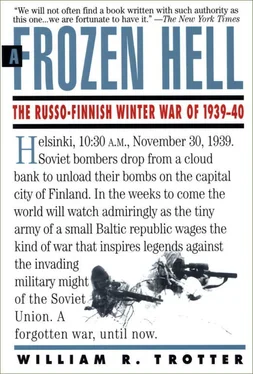With very few exceptions, his closest personal friends were not Finns but other European aristocrats. He generally disliked Germans and avoided them whenever possible. The story is told of a luncheon Mannerheim was forced, by the demands of protocol, to attend in the company of a pompous and overbearing German liaison officer. While the meal was still in progress, “this German officer produced a cigar before Mannerheim had finished eating and asked if it would bother the Marshal if he smoked it. Mannerheim fixed the Wehrmacht officer with a gaze that would penetrate armor plate and cut him dead by replying evenly: ‘I don’t know. No one has ever tried it.’” [12] Goodrich, Austin, Study in Sisu (New York: Ballantine Books, 1960), 22.
By his deep, ingrained hauteur, one is irresistibly reminded of Charles de Gaulle. Even in wartime there was something curiously “withheld” about Mannerheim, a remote quality which made it hard for subordinates to approach him with new ideas. He delegated authority grudgingly. He also seems to have been aware of this defect in his leadership style, for at most of his headquarters conferences he permitted his subordinates to speak first before he delivered his own views. His corps commanders found him a hard master. Östermann judged him cold, imperious, and unreasonable and after the war had harsh things to say about his generalship. Öhquist, who had a much higher regard for Mannerheim’s tactical grasp, also states that he was a harsh man to work for, an impossible man to please. Yet many other accounts display the Marshal as being courteous, even fatherly, with subordinates of low and middle rank; noblesse oblige, surely.
Though he was an autocrat to his bones, he had nothing in common with the dictators of his time, the Hitlers and Francos and Mussolinis, and seems to have regarded them as little men. For Stalin he may actually have felt a certain grudging respect, for at least the proportions of Stalin’s excesses were not without precedent in Russian history. But for the bureaucratic apparatus that kept Stalin in power—the purges, the gulags, the proliferation of party hacks throughout every level of Soviet society—he could only have felt contempt.
If Mannerheim’s politics seem inscrutably peculiar, it is probably because they are outside of all contemporary frames of reference. Totalitarianism itself, a postdemocratic form of reactionary spasm, was almost as alien to him as democracy. His ideals came from a lost world, a world where gentlemen in glittering uniforms conducted their business over sherry in gilded drawing rooms, and then adjourned, tiara-clad ladies at their sides, for an evening at the Imperial Ballet. Gustav Mannerheim would not have been out of place in the pages of a Tolstoy novel; but in the gray and airless chambers of modern parliamentary establishments, he was as anachronistic as an envoy from the court of Versailles.
CHAPTER 3
Order of Battle
Winston Churchill was not making idle hyperbole when he spoke, in the closing months of World War II, of the Red Army’s having “clawed the guts out of” the Wehrmacht. By the time Berlin fell to Marshal Zhukov’s armies, the Soviet war machine had become a tidal wave of brute steel and inexhaustible human reserves. Even at the end, when they were maneuvering worn-out companies against armored divisions, the Germans outfought and outkilled their Soviet counterparts by a ratio of five to one, and still it made no difference. Any Western general who would not admit to being afraid of the Red Army by 1945, with the possibly pathological exception of George Patton, was either ignorant or a liar. Nothing that has happened since 1945 has altered that menacing image: waves of tanks, hordes of men, armadas of aircraft that darkened the sky….
But in the early winter of 1939, those stereotyped images did not exist. The Red Army was an unknown quantity, not just to the West but also to its own commanders and strategists. Born in the helter-skelter campaigns of the civil war, when most of the action took place in the form of largescale partisan operations rather than conventional warfare, the Red Army was an untried, theoretically designed instrument. True, there had been a stunningly one-sided victory won by Marshal Zhukov against the Japanese at Khalkin Gol, in August 1939, but that had not been much of a contest. The Japanese were used to fighting barefoot armies of Chinese conscripts who had no air support and no significant armor; and the Japanese tanks were even more rickety, weakly armed, and mechanically unreliable than those of the Italians. Zhukov unleashed not only large formations of the latest Christie-designed armor but tactical air power on a scale the Japanese had not dreamed could exist, and he cut up their armies like so much warm butter. Moreover, all the fighting at Khalkin Gol had taken place on the open, treeless plains of Mongolia, ideal terrain for a Soviet-style blitzkrieg.
Finland would be a different story: it was the Red Army’s first campaign against a modern European foe, and it would be fought in terrain about as different from Mongolia’s as the surface of another planet. At least one Red Army strategist seems to have been aware of this: the chief of staff of the Red Army, General Shaposhnikov, studied the upcoming Finnish campaign with a cool, professional eye and did not like what he saw. He submitted a report to the Main Military Council that advocated a serious buildup, extensive logistical and fire-support preparation, and a rational, methodical order of battle, deploying the Red Army’s very best units, even if they had to be brought in from the Far East.
Stalin seems to have dismissed the report without much discussion, treating it in fact almost as a joke. He had been told by Zhdanov and Defense Commissar Voroshilov that the Finnish business could be taken care of by the resources on hand in the Leningrad Military District, and he believed them. After all, the Red Army had just finished inundating 200,000 square kilometers of Poland, inhabited by thirteen million people, at a cost of less than a thousand casualties. Stalin was not worried.
Zhdanov’s military commander, General Meretskov, at least had some doubts; in a report submitted just before the start of hostilities, he wrote, “The terrain of coming operations is split by lakes, rivers, swamps, and is almost entirely covered by forests…. The proper use of our forces will be difficult…. It is criminal to believe that our task will be easy, or only like a march, as it has been told to me by officers in connection with my inspection.” [1] Chew, Allen F., The White Death (East Lansing: Michigan State University Press, 1971), 256.
It does not appear, however, that Meretskov was entirely free to deploy his troops according to his own best judgment. Either that, or he just wrote the report in order to cover himself in case things went wrong. Motives, true feelings, and lines of responsibility are not very clear at this level of the Soviet command even today. The whole Finnish campaign was an embarrassment to the officer caste, and even half a century later there is little discussion of it in print on the Russian side.
Whatever his reasons, Meretskov publicly took the politically correct stance that the Finnish effort would be little more than a glorified police action, requiring two weeks at the most. By the time the fighting actually started, the only concern he expressed was for controlling his forward elements, lest some overzealous panzer commander blunder across the Swedish border.
Meretskov himself would have operational control over the Seventh, Eighth, Ninth, and Fourteenth armies—the entire Karelian front. In 1939, he was forty-two years of age. Of peasant origins, he had joined the party early, in May 1917, straight from his job as a factory worker. He distinguished himself in battle as a Red Guard and was eventually promoted to political commissar in the Red Army. Diligent if uninspired, he kept his nose clean politically, survived the purges, and by 1938 had reached the zenith of his career when Stalin appointed him commander of the Leningrad Military District.
Читать дальше












